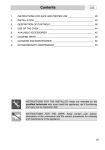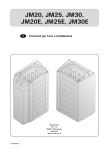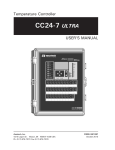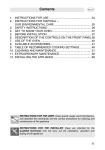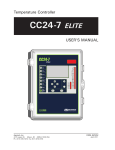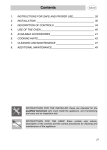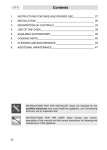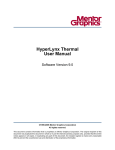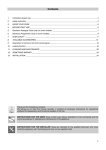Download Smeg JRP30GIBB Instructions for Installation and Use
Transcript
Contents 1. INSTRUCTIONS FOR SAFE AND PROPER USE________________ 4 2. INSTALLATION __________________________________________ 6 3. DESCRIPTION OF CONTROLS ____________________________ 10 4. USE OF THE OVEN ______________________________________ 16 5. AVAILABLE ACCESSORIES _______________________________ 17 6. COOKING HINTS ________________________________________ 18 7. CLEANING AND MAINTENANCE ___________________________ 24 8. EXTRAORDINARY MAINTENANCE _________________________ 28 Thank you for having preferred our product. From now on we feel sure you will enjoy creatively using your new oven. We recommend you to carefully read the instructions in this manual. A lot of room has been given to the best and most correct way of using the oven. These instructions will also make it easier for you to become acquainted with each single component or accessory. Useful hints are provided on how to use pans and cooking utensils, on correct guide positions and control settings. Be sure to follow the cleaning instructions carefully. That way your oven will give you many long years of reliable service. The single paragraphs illustrate oven operation, step by step. The text is easy to understand and completed with pictures and some of the most commonly used pictograms. By reading this manual carefully, you will find all the answers to your oven operation queries. INSTRUCTIONS FOR THE INSTALLER: these are intended for the qualified technician who must install the appliance, set it functioning and carry out an inspection test. INSTRUCTIONS FOR THE USER: these contain user advice, description of the commands and the correct procedures for cleaning and maintenance of the appliance. 3 Introduction 1. INSTRUCTIONS FOR SAFE AND PROPER USE THIS MANUAL IS AN INTEGRAL PART OF THE APPLIANCE AND THEREFORE MUST BE KEPT IN ITS ENTIRETY AND IN AN ACCESSIBLE PLACE FOR THE WHOLE WORKING LIFE OF THE OVEN. WE ADVISE CAREFUL READING OF THIS MANUAL AND ALL THE INSTRUCTIONS THEREIN BEFORE USING THE OVEN. INSTALLATION MUST BE CARRIED OUT BY QUALIFIED PERSONNEL IN ACCORDANCE WITH THE REGULATIONS IN FORCE. THIS APPLIANCE IS INTENDED FOR DOMESTIC USES AND CONFORMS TO CURRENT REGULATIONS IN FORCE. THE APPLIANCE HAS BEEN BUILT TO CARRY OUT THE FOLLOWING FUNCTIONS: COOKING AND HEATING-UP OF FOOD. ALL OTHER USES ARE CONSIDERED IMPROPER. THE MANUFACTURER DECLINES ALL RESPONSIBILITY FOR IMPROPER USE. DO NOT LEAVE THE PACKING IN THE HOME ENVIRONMENT. SEPARATE THE VARIOUS WASTE MATERIALS AND TAKE THEM TO THE NEAREST SPECIAL GARBAGE COLLECTION CENTRE. BEFORE THROWING AWAY AN OLD APPLIANCE, MAKE SURE THIS IS RENDERED HARMLESS AND DISPOSE OF IT THROUGH A PRE-SORTED WASTE COLLECTION CENTRE. IT IS OBLIGATORY FOR THE ELECTRICAL SYSTEM TO BE GROUNDED ACCORDING TO THE METHODS REQUIRED BY SAFETY RULES. WHEN LINKING UP TO MAINS BY PLUG AND SOCKET, MAKE SURE THAT BOTH ARE COMPATIBLE AND CONNECT BY MEANS OF A POWER CABLE COMPLYING WITH APPLICABLE REGULATIONS. THE SOCKET MUST BE ACCESSIBLE AFTER THE APPLIANCE HAS BEEN BUILT IN. NEVER UNPLUG BY PULLING ON THE CABLE. DO NOT OBSTRUCT VENTILATION OPENINGS AND HEAT DISPERSAL SLITS. IMMEDIATELY AFTER INSTALLATION CARRY OUT A BRIEF INSPECTION TEST OF THE OVEN, FOLLOWING THE INSTRUCTIONS BELOW. SHOULD THE APPLIANCE NOT FUNCTION, DISCONNECT IT FROM THE SUPPLY AND CALL THE NEAREST TECHNICAL ASSISTANCE CENTRE. NEVER TRY TO REPAIR THE APPLIANCE BY YOURSELF! IN CASE OF ONGOING FAULTS, TURN THE MAIN SWITCH OFF, DISCONNECT THE POWER SUPPLY AND CONTACT YOUR NEAREST DEALER. ALWAYS INSIST ON ORIGINAL SPARE PARTS. 4 Introduction ALWAYS CHECK THAT THE CONTROL KNOBS ARE IN THE “ZERO” (OFF) POSITION WHEN YOU FINISH USING THE OVEN. NEVER PUT INFLAMMABLE OBJECTS IN THE OVEN: THEY COULD BE ACCIDENTALLY LIGHTED AND CAUSE FIRES. THE I.D. PLATE WITH TECHNICAL DATA, REGISTRATION NUMBER AND BRAND NAME IS POSITIONED VISIBLY ON THE OVEN DOOR FRAME. THE PLATE MUST NOT BE REMOVED. THE OVEN IS DESIGNED FOR USE BY ADULTS. DO NOT ALLOW CHILDREN TO GO NEAR OR PLAY WITH IT. DURING THE AUTOMATIC CLEANING CYCLE (PYROLYSIS) THE OUTER DOOR WINDOW COULD BECOME HOTTER THAN NORMAL. KEEP CHILDREN AT A DISTANCE. THIS APPLIANCE IS MARKED ACCORDING TO THE EUROPEAN DIRECTIVE 2002/96/EC ON WASTE ELECTRICAL AND ELECTRONIC EQUIPMENT (WEEE). THIS GUIDELINE IS THE FRAME OF A EUROPEAN-WIDE VALIDITY OF RETURN AND RECYCLING ON WASTE ELECTRICAL AND ELECTRONIC EQUIPMENT. BEFORE THE APPLIANCE IS PUT INTO OPERATION, ALL THE LABELS AND PROTECTIVE FILMS APPLIED INSIDE OR OUTSIDE MUST BE REMOVED. The manufacturer declines all responsibility for damage to persons or things caused by non-observance of the above prescriptions or by interference with any part of the appliance or by the use of non-original spares. 5 Instructions for the installer 2. INSTALLATION 2.1 Electric installation - mains supply WARNING: This appliance must be earthed. This appliance interference. • • • • conforms with BSEN 55014 regarding radio frequency The appliance must be connected by a competent electrical contractor / engineer such as one who is registered with the National Inspection Council for Electrical Contracting (NIEIC). A Double Pole Control Switch with a minimum contact clearance of 3 mm must be fitted on or recessed into the wall adjacent to the appliance and must be accessible after installation to enable the appliance to be isolated for cleaning or in case of an emergency. The appliance should be checked to ensure that the rated voltage corresponds with supply voltage. Color coding of wiring: GREEN- and YELLOW = EARTH BLUE = NEUTRAL BROWN = LIVE As the colours of the wires in the mains lead of this appliance may not correspond with the colour markings identifying the terminals in your plug, proceed as follows: The wire coloured Green-and-Yellow must be connected to the terminal marked with "E" or ; The wire coloured Blue must be connected to the terminal marked "N" or coloured Black; The wire coloured Brown must be connected to the terminal marked "L" or coloured Red. 2.2 Electrical connection Check that mains voltage and power cable ratings are as per the indications provided on the label attached to the oven door frame. This label must never be removed. It is obligatory for the electrical system to be grounded according to the methods required by safety rules. If a plug and socket connection is being used make sure that the plug and socket are compatible. Avoid use of adapters and shunts as these could cause overheating and risk of burns. If a fixed connection is being used fit power line with an omnipolar circuit breaker with a contact opening gap equal to or greater than 3 mm in an easily accessible position in proximity to the oven. 6 Instructions for the installer 2.2.1 Ovens with top controls In the ovens with top controls the power cable is not supplied. Use a H05RR-F or H05RN-F rubber-sheathed cable making sure that it does not come into contact with any external metal parts of the oven when routing. Remove rear cover by loosening relevant screws to gain access to the terminal strip. If necessary change jumper configuration as shown in the figure and then connect wires making sure that the earth wire is at least 20 mm longer than the others. Secure power cable to oven by means of the appropriate fitting. . For operation on 230V∼: use an H05RR-F / H05RN-F type three-core cable (3 x 2.5 mm2). For operation on 400V2N∼: use an H05RR-F / H05RN-F type four-core cable (4 x 2.5 mm2). For operation on 400V3N∼: use an H05RRF / H05RN-F type five-core cable (5 x 1.5 mm2). The cable end to be connected to the appliance must be provided with an ground wire (yellow-green) at least 20 mm longer. The manufacturer declines all responsibility for damage to persons or things caused by non-observance of the above prescriptions or by interference with any part of the appliance. 7 Instructions for the installer 2.3 Mounting the oven The oven is designed for mounting into any piece of kitchen furniture being heat-resistant. Proceed according to the dimensions shown in Figures 1, 2 and 3. For installing under a work top, follow the dimensions given in Figure 1-3. For installing under a work top with combined heating plates, ensure a minimum clearance from any side walls of at least 110 mm as shown in Figure 1. For installing in a column, follow the dimensions given in Figure 1-2 allowing for a clearance of 80 to 90 mm at the top and sides of the column. Tighten the four screws A inside the frame to secure (Fig. 1). For installing beneath a non-integrated top, allow for a rear and bottom clearance as shown in Figure 1 (ref. B). See relevant instructions for fitting and securing the cook top. 8 Instructions for the installer Never use the oven door to lever the oven into place when fitting. Avoid exerting too much pressure on the oven door when open. 2.4 Connecting the cook top to the oven Once installed, the cook top must be connected to the oven. Mount the oven allowing enough room for the following operations to be made. • Connect the earth wire (yellow-green) of the cook top to the earth terminal A of the oven (see figure). • Fit the cook top connectors into the appropriate sockets in the top cover of the oven. Make sure that the colours and symbols of the connectors match those of the oven sockets. • If the cook top is equipped with a connector for the residual heat indicator, same must be fitted into the free socket on the right side. The oven can now be fully mounted into the cabinet; make sure that the power cable is properly routed and does not come into contact with parts which may become hot during operation. 9 Instructions for the user 3. DESCRIPTION OF CONTROLS 3.1 Front control panel All the oven controls are grouped together on the front panel. MODEL: JRS 30 MODEL: JRS 31 MODEL: JRP 30 DOOR LOCK INDICATOR LIGHT When this light comes on during automatic cleaning (pyrolysis), the door lock device is operative. THERMOSTAT INDICATOR LIGHT When this light comes on, the oven is heating up. When this light goes out, the preset heating temperature has been reached. When the light flashes, the temperature inside the oven is steady at the set temperature. This light also comes on during the automatic cleaning cycle (pyrolysis) and goes out when the set time has passed. THERMOSTAT KNOB Cooking temperature is selected by turning the knob clockwise to the desired setting, between 50° and 250°C. In the JRP 30 model, maximum temperature is 280°C. 10 Instructions for the user FUNCTION SWITCH KNOB Rotate the knob in either direction to select desired function from the following: NO FUNCTION SET UPPER AND LOWER HEATING ELEMENT UPPER AND LOWER HEATING ELEMENT + VENTILATION GRILL ELEMENT GRILL ELEMENT + VENTILATION LOWER HEATING ELEMENT VENTILATED HEATING ELEMENT UPPER AND LOWER HEATING ELEMENT + VENTILATED HEATING ELEMENT GRILL + ROTISSERIE DEFROSTING AUTOMATIC CLEANING CYCLE (PYROLYSIS) COOK TOP CONTROL KNOB Permits to adjust cook top heating. Rotate clockwise to set to desired value (2 to 12). COOK-TOP CONTROL KNOB WITH DOUBLE HEATING Permits to select heating zone in plates with double heating zones. Rotating the knob clockwise from between 2 to 12 heats the inner zone within the small diameter. Turn the knob all the way around beyond 12 and release. This causes the knob to return to 12 and both diameters to heat up. To adjust heat intensity, turn the knob anticlockwise to the desired value. To return to heating inside the inner zone only, set knob first to 0 and then to any value between 2 and 12 as desired. 11 Instructions for the user 3.2 Electronic programmer LIST OF FUNCTIONS MINUTE-COUNTER KEY COOKING TIME KEY END-OF-COOKING KEY MANUAL OPERATION KEY TIME BACK KEY TIME FORWARD KEY 3.2.1 Clock adjustment When using the oven for the first time, or after a power failure, the display flashes regularly and indicates . To stop flashing, press key on the display. By pressing keys or each single press changes the time by 1 minute either up or down. Press one of the two keys until the right time appears. Before setting the programmer activate the desired function and temperature. 3.2.2 Semiautomatic cooking Use this setting for automatic oven switch-off at the end of cooking time. 12 Instructions for the user By pressing key , the display lights up, showing pressed and at the same time, press keys time. or ; keep the key to set the cooking Release key to start the programmed cooking time count. The display will now show the right time together with symbols AUTO and . 3.2.3 Automatic cooking Use this setting to automatically start and stop the oven. By pressing key , the display lights up showing pressed and at the same time, press keys time. By pressing key or ; keep the key to set the cooking the sum of the right time + cooking time will appear; keep the key pressed and at the same time, press keys regulate the end of cooking time. or to Release key to start the programmed count and the display will show the right time together with symbols AUTO and . After setting, to see how much cooking time is left, press key end of cooking time, press key ; to see . 3.2.4 End of cooking When cooking is over, the oven will automatically switch off and, at the same time, an intermittent alarm will sound. After switching off the alarm, 13 Instructions for the user the display will once again show the right time together with the symbol , indicating that the oven has returned to manual operation mode. 3.2.5 Adjusting alarm volume The acoustic alarm has three different settings. These can be operated, . while the alarm is sounding, by pressing key 3.2.6 Switching off the alarm The alarm switches off automatically after seven minutes. It can be manually turned off by pressing key . 3.2.7 Minute-counter The programmer can also be used as a simple minute counter. The use of the minute-counter will not interrupt oven operation at the end of the set time. By pressing key , the display shows ; keep the key pressed or . By releasing the key , and at the same time press keys the programmed count starts and the symbols and appear on the monitor. After programming the minute-counter, the display will show the right time. to display remaining time, press key . Wrong settings are prevented logically (e.g., any conflict between end of cooking time and a longer time will not be accepted by the programmer). 14 Instructions for the user 3.2.8 Cancellation of set data Once the programme has been set, keep the key of the function to be cancelled pressed, while at the same time is reached by means of variation keys or . Time cancellation will be considered as end-of-cooking time by the programmer. 3.2.9 Changing the set data The cooking data entered can be changed at any time by keeping the function key pressed and at the same time adjusting the keys or . 15 Instructions for the user 4. USE OF THE OVEN Before turning on the oven, make sure that the symbol Clock adjustment") appears on the display. (see "3.2.1 4.1 Warnings and general advice Before using the oven for the first time, pre-heat it to maximum temperature long enough to burn any manufacturing oily residues which could give the food a bad taste. After a power failure, the display will flash at regular intervals showing . To regulate, refer to paragraph "3.2 Electronic programmer ". During cooking, do not cover the bottom of the oven with aluminium or tin foil and do not place pans or oven trays on it as this may damage the enamel coating. If you wish to use greaseproof paper, place it so that it will not interfere with the hot air circulation inside the oven. To prevent any steam in the oven creating problems, open the door in two stages: half open (5 cm approx.) for 4-5 seconds and then fully open. To access food, always leave the door open as short a time as possible to prevent the temperature in the oven from falling and ruining the food. 4.2 Cooling ventilation The appliance is fitted with coolings fan which come on when the oven is turned on. The fans cause a flow of air which comes out of the lower part of the oven front and which may briefly continue after the oven has been turned off. PYROLYSIS: once the cleaning cycle has started, the fans only operate when the oven has achieved a preset temperature. 4.3 Oven light To turn on the light, set the function selector knob to any symbol or, with oven turned off, simply open the door. 16 Instructions for the user 5. AVAILABLE ACCESSORIES The oven features 4 support positions for plates and racks of different height. Some models do not feature all accessories. Grill: useful for holding cooking vessels. Plate grill: for placing above plate for cooking foods that might drip. Tubular tray-holder rack: for cooking food on plates, small cakes, roasts or food requiring light grilling. Oven plate: useful for catching fat from foods on the grill above. Pastry plate: for baking cakes, pizza and oven desserts. Rotisserie frame: to be mounted in the oven guides before fitting the spit. Rotisserie: suitable for cooking whole chickens, sausages and any other food requiring even cooking on all surfaces. Roof liner/Grill guard: removing this simplifies cleaning procedures inside the oven. Chromium-plated tubular gripper for removing hot racks and plates from the oven. Accessories available on request Original accessories may be ordered from any Authorised Service Centre. 17 Instructions for the user 6. COOKING HINTS In fan-assisted mode preheating should be carried out at 30/40°C above the cooking temperature. This considerably shortens cooking times and reduces power consumption, as well as giving better cooking results. 6.1 Traditional cooking FUNCTION SWITCH THERMOSTAT SWITCH 50 ÷ 250°C This traditional cooking method, in which heat comes from above and below, is suitable for cooking food on a single level. You have to preheat the oven until the set temperature is reached. Place the food in the oven only after the thermostat indicator light has turned off. very fatty meats may be put in when the oven is still cold. Put frozen meat in immediately, without waiting for it to thaw. The only precaution you need to take is to set the temperature about 20°C lower and cooking time about 1/4 longer than you would for fresh meat. 6.2 Hot-air cooking FUNCTION SWITCH THERMOSTAT SWITCH 50 ÷ 280°C This system is suitable for cooking on several levels, including different types of food (fish, meat etc.), without the tastes and smells mingling. Air circulation in the oven ensures a uniform distribution of heat. 18 Instructions for the user Multiple cooking is possible as long as the cooking temperature of the different foods is the same. 6.3 Grill cooking FUNCTION SWITCH THERMOSTAT SWITCH 280°C Permits rapid browning of foods. You are advised to place the pan in the highest guide. For short-term cooking of small quantities, place the grid in the fourth guide from the bottom. For long-term cooking and grills, put the grid in the lowest guide in accordance with the size of the pieces. Keep the oven door closed during grilling. Grilling with the door open could permanently damage the oven and affect safety of operation. 6.4 Hot-air grilling FUNCTION SWITCH THERMOSTAT SWITCH 280°C Ensures uniform heat distribution with greater heat penetration into the food. Food will be lightly browned on the outside and remain soft inside. Keep the oven door closed during cooking. Heating up time must not exceed 60 minutes. Keep the oven door closed during grilling. Grilling with the door open could permanently damage the oven and affect safety of operation. 19 Instructions for the user 6.5 Delicate cooking FUNCTION SWITCH THERMOSTAT SWITCH 50 ÷ 280°C Ideal for pastries and cakes with wet covering and little sugar and damp desserts in moulds. Excellent results can also be achieved in completing cooking at the bottom and with dishes requiring heat in the lower area in particular. The plate is best inserted at bottom level. 6.6 Defrosting FUNCTION SWITCH THERMOSTAT SWITCH IN POSITION 0 The flow of air produced by the fan ensures quicker defrosting. The air circulating inside the oven is at room temperature. The advantage of defrosting at room temperature is that it does not alter the taste and appearance of the food. 20 Instructions for the user 6.7 Rotisserie FUNCTION SWITCH THERMOSTAT SWITCH 280°C This is an energy saving-cooking system. Place the food at the centre of the plate or rack and cook as indicated in paragraph “6.3 Grill cooking”. Recommended for small pieces only. Prepare the food on the spit rod and block fork screws A. Insert the frame B in the second level from the bottom. Remove handle D and position the spit rod so the pulley E remains guided on frame B. Completely fit frame B until the tip of the spit rod fits into hole C on the back wall of the oven. Place an oven dish F on the bottom guide and pour in a little water to prevent smoke from forming. It is normal for the thermostat light to flash during cooking. This indicates the temperature inside the oven is regular (above all when the oven door is closed). Make sure the food is centered well on the spit to ensure best results. 21 Instructions for the user 6.8 Recommended cooking table Cooking times, especially meat, vary according to the thickness and quality of the food and to consumer taste. TRADITIONAL COOKING FIRST COURSES LASAGNE OVEN-BAKED PASTA MEAT ROAST VEAL ROAST BEEF ROAST PORK CHICKEN DUCK GOOSE - TURKEY RABBIT LEG OF LAMB FISH PIZZA DESSERTS SHORT PASTRY CIAMBELLA BRIOCHES FRUIT CAKE PARADISE CAKE APPLE CAKE RICE CAKE (*) = WITH PREHEATED OVEN LEVEL FROM BELOW TEMPERATURE (°C) TIME IN MINUTES (*) 2-3 2-3 210 - 230 210 - 230 30 40 2 2 2 2 2 2 2 2 1-2 170 - 200 210 - 240 170 - 200 170 - 200 170 - 200 140 - 170 170 - 200 170 - 200 170 - 200 1-2 210 - 240 30 - 40 / KG. 30 - 40 / KG. 30 - 40 / KG. 45 - 60 45 - 60 45 - 60 50 - 60 40 - 50 ACCORDING TO DIMENSIONS 40 - 45 1-2 1-2 1-2 1-2 1-2 1-2 1-2 170 - 200 165 170 - 200 170 - 200 170 190 180 15 - 20 35 - 45 40 - 45 20 - 30 60 60 60 GRILLING LEVEL FROM BELOW PORK CHOPS FILLET OF PORK FILLET OF BEEF LIVER VEAL ESCALOPES HALF CHICKEN SAUSAGES MEAT-BALLS FISH FILLETS TOAST 22 4 3 3 4 4 3 4 4 4 4 TIME IN MINUTES FIRST SURFACE 7-9 9 - 11 9 - 11 2-3 7-9 9 - 14 7-9 7-9 5-6 2-4 SECOND SURFACE 5-7 5-9 9 - 11 2-3 5-7 9 - 11 5-6 5-6 3-4 2-3 Instructions for the user HOT-AIR COOKING FIRST COURSES LASAGNE OVEN-BAKED PASTA CREOLE RICE MEAT ROAST VEAL ROAST PORK ROASTED BEEF FILLET OF BEEF ROAST LAMB ROAST BEEF ROAST CHICKEN ROAST DUCK ROAST TURKEY ROAST RABBIT ROAST HARE ROAST PIGEON FISH PIZZA BREAD TOAST DESSERTS CIAMBELLA FRUIT CAKE BRIOCHES SHORT PASTRY RICE CAKE APPLE CAKE PARADISE CAKE LEVEL FROM BELOW TEMPERATURE (°C) TIME IN MINUTES 2 2 2 190 - 210 190 - 210 190 - 220 20 - 25 25 - 30 20 - 25 2 2 2 2 2 2 2 2 2 2 2 2 2-3 150 - 170 150 - 160 160 - 170 160 - 180 130 - 150 170 - 180 170 160 - 170 150 - 160 150 - 160 160 - 170 140 - 170 150 - 170 2-3 2-3 1-2 210 - 240 190 - 210 220 - 240 65 - 90 70 - 100 65 - 90 35 - 45 100 - 130 40 - 45 70 - 90 100 - 160 160 - 240 80 - 100 30 - 50 15 - 25 ACCORDING TO DIMENSIONS 30 - 50 40 7 2-3 2-3 2-3 2-3 2-3 2-3 2-3 150 - 170 170 - 190 160 - 170 170 - 180 170 180 160 35 - 45 40 - 50 40 - 60 20 60 60 60 23 Instructions for the user 7. CLEANING AND MAINTENANCE Before performing any operations requiring access to powered parts, switch off the power supply to the machine. 7.1 Cleaning stainless steel To keep stainless steel in good condition it should be cleaned regularly after use. Let it cool first. 7.2 Door glass Always keep this clean. Use absorbent kitchen paper. In the case of persistent dirt, wash with damp sponge and regular detergent. 7.3 Outer oven structure Wash with water and regular detergent. 7.4 Enamelled parts Wait for the oven to cool, take out all the removable parts and proceed to wash with water and regular detergent. Dry and replace components. For cleaning enamelled parts, never use abrasive products, metal wire sponges or sharp objects so as not to damage the surface. Remove any dried remains of food on surfaces with a wooden or plastic utensil. 24 Instructions for the user 7.5 Cleaning of the oven For best oven upkeep clean regularly after having allowed to cool. Take out all removable parts. • • Clean the oven grill and side guides with hot water and non-abrasive detergent. Rinse and dry. Clean the internal walls of the oven with a soft ammoniac-soaked cloth. Rinse and dry. If there are still stains or drops, place a damp ammoniac-soaked cloth on the bottom of the oven, close the door and after a few hours wash the oven with hot water and liquid detergent. Rinse and dry. 7.6 Pyrolysis: automatic oven cleaning Pyrolysis is an automatic high-temperature cleaning method which causes dirt to dissolve. BEFORE STARTING THE AUTOMATIC CLEANING CYCLE, MAKE SURE THE OVEN IS EMPTY AND DOES NOT CONTAIN FOOD OR ANYTHING ELSE. A DOOR LOCK DEVICE PREVENTS THE DOOR BEING OPENED. IN CASE THE OVEN IS INSTALLED UNDER A COOKTOP, MAKE SURE THAT DURING THE AUTOMATIC CLEANING CYCLE ANY GAS OR ELECTRIC HOBS ARE TURNED OFF. IN CASE A MICROWAVE OVEN IS INSTALLED ABOVE THE OVEN, MAKE SURE DEVICE IS SWITCHED OFF DURING PYROLITIC CYCLE. 25 Instructions for the user 7.6.1 Before starting the automatic cleaning cycle The Pyrolysis process can be performed at any time of the day or night (to take advantage of lower night-time electricity rates). Before proceeding, check the following: • remove all the accessories from the oven (some of them will not withstand heat and become damaged and/or deformed); • remove the most obvious traces of dirt (Pyrolysis cleaning would take too long); • make sure the oven door is properly closed; • when setting the cleaning cycle, remember the following: DURATION OF CLEANING : NOT VERY DIRTY 90 MIN. DIRTY 105 MIN. VERY DIRTY 120 MIN. THE FIRST AUTOMATIC CLEANING CYCLE COULD CAUSE BAD SMELLS DUE TO EVAPORATION OF OILY SUBSTANCES USED DURING MANUFACTURE. THIS IS A QUITE NORMAL OCCURRENCE WHICH DISAPPEARS AFTER THE FIRST CLEANING CYCLE. DURING THE AUTOMATIC CLEANING CYCLE, THE FANS MAKE MORE NOISE DUE TO GREATER ROTATION SPEED. THIS IS QUITE NORMAL AND IS INTENDED TO FAVOUR THE ELIMINATION OF HEAT. AFTER PYROLYSIS, VENTILATION CONTINUES AUTOMATICALLY FOR LONG ENOUGH TO PREVENT THE CABINET WALLS AND FRONT OF THE OVEN FROM OVERHEATING. 7.6.2 How the automatic cleaning cycle works The following table shows an example of automatic cleaning cycle operation. When the cleaning cycle is set, the thermostat light comes on, while the door lock device (and indicator light) is not engaged. When the temperature reaches 300°C, a lock device triggers to prevent door opening. At the end of the cleaning cycle, the thermostat indicator light goes off. The door-lock is only released afterwards when the temperature inside the oven has dropped below 300°C. 26 Instructions for the user ON - ON 300 °C OFF 500 °C OFF 300 °C 7.6.3 Setting the automatic cleaning cycle FUNCTION SWITCH MINIMUM DURATION OF CLEANING CYCLE Position the function selector switch on the symbol : the thermostat indicator light will come on and the programmer will automatically set on a minimum pyrolysis time of . To display or regulate this time, press key and increase/decrease keys or . Pyrolysis time can be set to a maximum of 3 hours. The cleaning cycle can be programmed so it starts at a specific time. and change the setting by means of setting variation keys Press key or . 27 Instructions for the user 8. EXTRAORDINARY MAINTENANCE The oven may require extraordinary maintenance or replacement of parts subject to wear such as seals, bulbs, and so on. The following instructions describe how to carry out these minor maintenance operations. Before any intervention, disconnect the power supply of the device. 8.1 Replacement of light bulb Remove the bulb protector A by turning anticlockwise and change bulb B with a similar one. Re-fit the bulb protector A. Only use oven bulbs (T 300°C). If in doubt ask your dealer. 28 Instructions for the user 8.2 Removing the door Hold the door on both sides with both hands near hinges A and raise levers B. Lift up the door forming an angle of about 45° and remove. To refit, slide the hinges A in the grooves, drop the door and release levers B. Move door carefully without brut forle. When door removed, be careful with the hinges being under pressure. 8.3 Oven door seal (mod. JRS 30 / JRS 31) To permit thorough cleaning of the oven, the seal may be removed. Before removing the seal, take off the door as described above. Once the door has been taken off, lift the tabs at the corners as shown in the figure. After cleaning, refit the seal with the longer side horizontal and insert the tabs into the appropriate holes starting from the top ones. 29




























